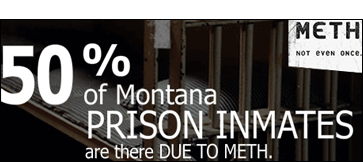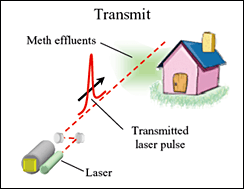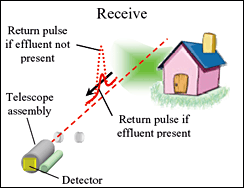BOZEMAN, Mont., July 26, 2007 -- Montana's frontier lore has been fodder for countless shoot 'em ups, but it's hard to imagine a less likely setting -- Big Sky, open land, majestic mountains -- for an out-of-control methamphetamine (meth) abuse problem.
In fact, meth use in Montana is dramatically higher than the national average, and almost 3/4 of the state's federal sentences were meth-related in 2003. Not swayed by the scenery, the state has its sights on enforcement and prevention. And a Bozeman company is offering a photonics approach to the problem.
Peter A. Roos, cofounder, president and CEO of Bridger Photonics, returned to Bozeman in 2005 to join a team of applied laser physics researchers at Spectrum Lab, part of Montana State University (MSU), where he had been a graduate student.
Bozeman, in the Gallatin Valley, has your typical Montana-style clean air and snow-capped mountain ranges. Nearly a million tourists a year pass through it (en route to Yellowstone National Park), and A River Runs Through It and The Horse Whisperer were filmed nearby. It was named after John M. Bozeman, founder of the Bozeman Trail, a shortcut connecting the Oregon Trail to gold-rush territory. Today the city (pop. approximately 27,500) is home to 85 high-tech companies -- many of them founded by MSU graduates -- and its economy is lately described as booming.
Back in Bozeman, Roos quickly became aware of the meth epidemic, thanks to an aggressive and graphic advertising campaign being waged by the Montana Meth Project. The statewide effort -- conceived and founded by billionaire Montana rancher Thomas Siebel and supported by community outreach and public policy initiatives -- takes a consumer marketing approach to prevent the use of meth (also known as crank, crystal or speed, and many other slang terms).
Like the ad campaign, the Montana Meth Project Web site graphically illustrates the consequences of meth use. (In March, the project and HBO aired Montana Meth, a one-hour documentary that takes a similarly unflinching look at the problem.) The large-scale, statewide "Not Even Once" campaign, which aims to nip meth use in the bud, began in 2005. The hard-hitting messages, targeting Montana youths ages 12 to17, reportedly reach 70 to 90 percent of that audience three times a week via TV, radio, billboards, newspapers and the Internet. The ads boldly impose on audience comfort to depict the duplicity inherent in meth addiction and the particular intensity of its addictive properties, and its victims' desperation.
Image from Montana Meth Project Web site
"Not Even Once" even won a prestigious Bronze Lion Award at the 54th Annual Cannes International Advertising Festival, held last month in Cannes, France -- among many other advertising-industry accolades (notably, seven ADDY awards and two gold Effie awards; it was also a finalist for the Grand Effie award, alongside brands such as Apple, Philips Norelco and American Express).
Roos co-founded Bridger Photonics in 2006 as a spinoff of Spectrum Lab, which originated the concept of a meth lab detector, to bring it and other laser-based technologies to market. (One homeland security application Bridger is currently pursuing is to modify the sensor for compact detection of anthrax.) The company is closely tied with MSU through Spectrum Lab and its departments of engineering, physics and chemistry.
The commercialization of the meth-lab detector is one component of a larger plan at MSU's Spectrum Lab to battle the meth problem with science and technology.
 |  |
A schematic for laser remote sensing. A light pulse goes out, and the returning pulse is attenuated if meth effluents are present. (Illustrations courtesy Bridger Photonics)
|
Working with Roos are Randy Reibel and Jay Brasseur, PhD. Reibel is a co-founder, vice president and COO of Bridger Photonics -- who has a background in optical signal processing and sensor technologies and "a unique combination of applied research and development and commercial expertise," Roos said. Brasseur is a co-founder and technical advisor, and is also vice president of laser technologies at another company, Directed Energy Solutions; he has extensive experience in a variety of solid-state, gas and liquid high-power laser systems.
Roos, who is skilled in laser development, Raman systems and nonlinear optics, did undergraduate work at the University of Colorado, his graduate work at MSU (with a year in Australia as a Fulbright Fellow) and postdoctoral research at JILA and the National Institute of Standards and Technology in Boulder.
"Returning to Montana and being able to work on a project with so much potential benefit for the state has been a great homecoming for me," he said.
"I think it says a lot about the state that our citizens and politicians are so active and willing to devote effort to finding solutions to the meth problem. More than anything, it shows that we care about our communities and people. We are using our higher-than-average meth use as motivation to become a national leader in the fight against meth, from both societal and technological standpoints," he said.
Spectrum Lab said in a press release, "The drug is often implicated in violent crimes and is rapidly becoming more popular with teenagers and minorities. Meth use in Montana is dramatically higher than the national average, and almost 3/4 of the state's federal sentences were meth-related in 2003."
Montana also ranks among the top 10 states nationally in per capita treatment admissions for methamphetamine. According to the Meth Project, 52 percent of children in foster care in that state are there due to meth (at a cost to the state of $12 million a year), 50 percent of adults in prison are there due to meth-related crime (cost to the state: $43 million a year) and 20 percent of adults in treatment are there for meth addiction ($10 million a year). "The social costs are staggering. The human costs are incalculable."
Randy Babbitt, director of Spectrum Lab and an MSU professor, said 65 percent of Montana's young adults in 2005 reported meth is 'very or somewhat easy' to obtain. "Meth's abundant availability is often attributed to the fact that it is alarmingly easy to produce and that makeshift clandestine labs are now ubiquitous -- in homes, apartments, motels, storage facilities, etc." The Montana Meth Project is credited with making tremendous strides in the struggle. Teen use of the drug decreased 38 percent since its inception, and positive workplace test results fell by more than 70 percent. Current ads focus on "collateral damage" to meth users' family and friends. Meth is known for its ability to cross gender, socioeconomic and age barriers; and at least in Montana, the problem knows no geographic boundaries.
Such aggressive prevention efforts are showing significant progress, but complementary ones to address the supply side of the meth problem are direly needed, said Babbitt.
Meth is derived from amphetamine and is commonly made using the base chemicals ephedrine or pseudoephedrine found in over-the-counter medicines, according to the Meth Project Web site. Other common household products can be added to make meth, including acetone, iodine, anhydrous ammonia (fertilizer), hydrochloric acid (pool supply), lithium (batteries), red phosphorus (matches or road flares), sodium hydroxide (lye), sulfuric acid (drain cleaner) and toluene (brake fluid).
Although there are various ways to produce meth, most involve the use of toxic and volatile substances that can pose a threat to the surrounding area. An odor similar to that of cat urine and other offensive fumes often signify that an illegal meth lab is in operation, the project said.
When manufactured by amateurs, the production of meth can be extremely dangerous and create harmful, toxic gases. One production method involves heating anhydrous ammonia -- an extremely reactive ingredient that is prone to explosion. Many illegal meth labs are only discovered after fires or explosions occur due to the improper handling of these toxic chemicals, and cleanup is both hazardous and expensive.
These meth labs are becoming increasingly difficult for law enforcement to uncover as the producers become more sophisticated and mobile, and drug enforcement personnel need a way to rapidly detect the labs "in widely varying locations and circumstances," Babbitt said -- "a capability which currently does not exist."
With a grant from the National Science Foundation Small Business Technology Transfer Phase I project, Spectrum Lab is working with Bridger Photonics to develop sensitive, portable, low-cost, laser-based remote sensing devices to detect chemical byproducts of illicit methamphetamine (meth) production from a distance. The Phase I research objective will be to develop an innovative laser source that is ideally suited to this purpose.
To accomplish this objective, Bridger Photonics and Montana State University's Spectrum Laboratory will advance a locally developed, compact, monolithic laser design that Roos said has proven to be "incredibly effective for ranging purposes in demanding environments." An advanced version of this laser will be the primary component of a sensitive handheld device for detecting meth labs at a distance.
Laser remote sensing is used to detect the meth-related chemicals, and each meth chemical absorbs a unique set of wavelengths; therefore, when a laser wavelength matches these absorption features, the laser light will be absorbed. This absorption of the laser light signifies the presence of the meth chemicals, Roos said. (Details are kept confidential; countermeasures to such efforts, when they are discovered, are commonly circulated among users, e.g., on the Internet.)
Last year, Spectrum Lab established the Remote Methamphetamine Detection Initiative (REMEDI), a partnership involving academics, law enforcement, state and federal government entities, technology transfer centers, not-for-profit organizations and industry.
The REMEDI partnership also provides an excellent opportunity for students to get involved with research that directly affects them and their peers, Roos said. The partnership will focus on advancing the knowledge of meth-related chemicals and developing a number of technologies for detecting them (for which Babbitt is seeking funding opportunities).
"Bridger Photonics' close partnership with the REMEDI team members will ensure that the developed technologies are made available to law enforcement agencies as rapidly as possible," Roos said.
Also participating in REMEDI are Bozeman photonics companies Flir Systems' Bozeman division; Scientific Materials Corp., a manufacturer of high-performance laser materials, components and systems; and AdvR Inc., experts in optical wavelength conversion technology.
Academic members include MSU Extension Services, the MSU TechLink Center and the University of Montana Center for Environmental Health Sciences. Government partners are the Montana Department of Justice, for device field testing; the state governor's office; and Pacific Northwest National Labs, a Richland, Wash., US Department of Energy government research laboratory, which is contributing expertise in infrared spectroscopy.
In addition to the Montana Meth Project, nonprofits involved in the effort include the Montana-Wyoming Tribal Leaders Council and TechRanch, a Montana small-business development assistance program.
For more information, visit: bridgerphotonics.com